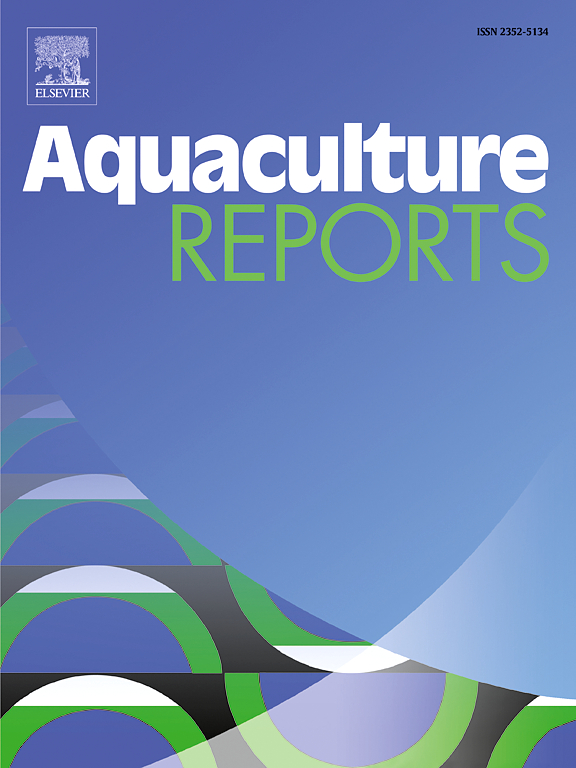Physiological performance and cardiac morphology of Atlantic salmon reared under slow and fast growth conditions
IF 3.2
2区 农林科学
Q1 FISHERIES
引用次数: 0
Abstract
Early rearing environment affects performance later in life. In Atlantic salmon (Salmo salar) aquaculture intensive smolt production has been linked to deviating cardiac morphology and increased mortality risks following stressful events during the marine production phase. To investigate the effects of early growth environment on later life-stages, two smolt groups were produced; a fast-growing group reared at 13 °C under continuous light and a slow-growing group reared at 6 °C under a natural photoperiod. The two groups were smoltified and transferred to 9 °C seawater at the same time and at similar sizes, although the slow smolts were ≈ 1000 day degrees older. Respirometry and swim tunnel experiments were performed to assess physiological performances along with morphological analyses of the hearts. We hypothesized that the slower growth trajectory would allow for the development of heart morphology more resembling that of wild salmon and that this should translate into improved physiological performance. Fast-growing smolt had more misaligned and enlarged bulbi as well as asymmetric ventricles compared to slow-growing smolt. However, contrary to our hypothesis, we did not find clear evidence for impaired physiological performance in fast-growing fish. That is, neither standard nor maximum metabolic rates, absolute critical swimming speed, stress recovery, or haematological parameters at fatigue differed between treatments. Mortality risks associated with deviating cardiac morphology first tend to occur in larger sized fish than investigated here. We therefore conclude that while early rearing environment clearly modulates cardiac morphology, recently seawater adapted Atlantic salmon do not yet show signs of compromised functionality associated with cardiac morphological differences at the whole-animal level. Future research should aim to incorporate larger sized fish in physiological experiments for a more appropriate representation of the latter production phase in Atlantic salmon aquaculture and its associated fish welfare problems.
慢速和快速生长条件下大西洋鲑鱼的生理性能和心脏形态
早期的养育环境会影响以后的表现。在大西洋鲑鱼(Salmo salar)养殖中,集约化小鲑鱼生产与海洋生产阶段应激事件后心脏形态偏离和死亡风险增加有关。为了研究早期生长环境对后期生活阶段的影响,我们生产了两组幼鱼;快速生长组在13°C连续光照下饲养,慢生长组在6°C自然光周期下饲养。两组幼崽在同一时间被孵化并转移到9°C的海水中,大小相似,但慢龄幼崽的年龄约为 1000 天度。通过呼吸测量和游泳隧道实验来评估心脏的生理机能以及形态学分析。我们假设,较慢的生长轨迹将允许心脏形态的发展更类似于野生鲑鱼,这应该转化为改善的生理性能。与生长缓慢的幼鱼相比,快速生长的幼鱼有更多的球状体和增大的球状体,以及不对称的心室。然而,与我们的假设相反,我们没有发现生长迅速的鱼类生理性能受损的明确证据。也就是说,标准代谢率和最大代谢率、绝对临界游泳速度、应激恢复或疲劳时的血液学参数在不同的治疗中都没有差异。与本研究相比,与心脏形态偏离相关的死亡风险首先倾向于发生在体型较大的鱼类身上。因此,我们得出结论,虽然早期饲养环境明显调节心脏形态,但最近适应海水的大西洋鲑鱼在整个动物水平上尚未显示出与心脏形态差异相关的功能受损的迹象。未来的研究应旨在将较大的鱼类纳入生理实验,以便更适当地反映大西洋鲑鱼养殖的后期生产阶段及其相关的鱼类福利问题。
本文章由计算机程序翻译,如有差异,请以英文原文为准。
求助全文
约1分钟内获得全文
求助全文
来源期刊

Aquaculture Reports
Agricultural and Biological Sciences-Animal Science and Zoology
CiteScore
5.90
自引率
8.10%
发文量
469
审稿时长
77 days
期刊介绍:
Aquaculture Reports will publish original research papers and reviews documenting outstanding science with a regional context and focus, answering the need for high quality information on novel species, systems and regions in emerging areas of aquaculture research and development, such as integrated multi-trophic aquaculture, urban aquaculture, ornamental, unfed aquaculture, offshore aquaculture and others. Papers having industry research as priority and encompassing product development research or current industry practice are encouraged.
 求助内容:
求助内容: 应助结果提醒方式:
应助结果提醒方式:


